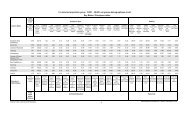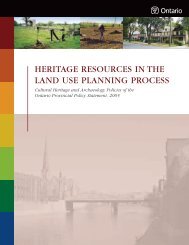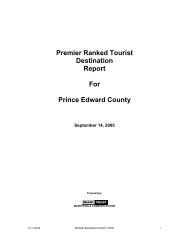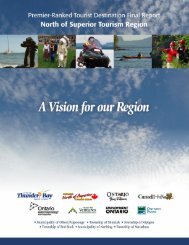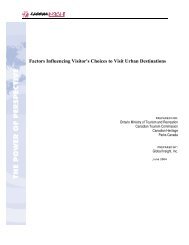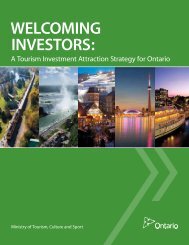Management Guidelines For Forestry and Resource-Based Tourism
Management Guidelines For Forestry and Resource-Based Tourism
Management Guidelines For Forestry and Resource-Based Tourism
- No tags were found...
Create successful ePaper yourself
Turn your PDF publications into a flip-book with our unique Google optimized e-Paper software.
<strong>Management</strong> <strong>Guidelines</strong> for <strong>For</strong>estry <strong>and</strong> <strong>Resource</strong>-<strong>Based</strong> <strong>Tourism</strong> – APPENDIX 3Generally speaking "tourism values" are natural or culturalresources found in the forest which are important to atourism activity or experience in which tourists participate.Ultimately it is the tourist who defines a tourism value.Values should relate, then, to the dem<strong>and</strong> individuals havefor the product/experience. Ontario’s tourist industry catersto a diverse range of clients. The diversity in client baserenders the task of defining tourist values problematic. Theindustry has traditionally been classified as remote, semiremote <strong>and</strong> drive-in <strong>and</strong> depends on the availability <strong>and</strong>maintenance of a number of important values. Remoteness<strong>and</strong> wilderness are highly valued by segments of the touristindustry. These criteria do not address remoteness <strong>and</strong>wilderness; however, this in no way diminishes theirsignificance.Definitions:<strong>Tourism</strong> value<strong>For</strong> the purposes of proposing forestry prescriptions ina <strong>Resource</strong> Stewardship Agreement a tourism value isdefined as a feature on a map. Once defined on a map<strong>and</strong>, if forest operations are planned which may affect thefeature, prescriptions are developed to protectthe feature.Criteria for mapping tourism values1. The value must be capable of being defined spatially.<strong>For</strong> this mapping exercise values must be tangible; somethingthat can be pointed to <strong>and</strong> touched or seen. There isa distinction between the value, the experience associatedwith a set of values <strong>and</strong> the measures taken to protect thevalue <strong>and</strong> associated experience. Both the value <strong>and</strong> associatedexperience have value to the tourism operator <strong>and</strong>must be considered in the development of a forest managementplan or RSA. Remoteness <strong>and</strong> wilderness are importantvalues to the tourism industry; however, they are notvalues which will be entered into NRVIS.Ontario’s <strong>Resource</strong>-<strong>Based</strong> <strong>Tourism</strong> Policy provides definitionfor three categories of resource-based tourism:remote, semi-remote <strong>and</strong> drive-in based on the level ofexisting access.2. The mapped information must be accurateDecisions which consider the information can result insignificant costs or losses to business.3. The information must be verifiableDecisions made <strong>and</strong> the actions taken as a result of thesedecisions will form part of a forest management plan.<strong>For</strong>est management plans are legal documents, subject toaudit <strong>and</strong> periodic review.4. The information must be timelyNot all information may be readily available. When informationgaps are apparent efforts should be made to gathersufficient information to consider the value effectively inan RSA <strong>and</strong> forest management plan. While some delaymay be inevitable, extraordinary delays can upset theapproval of a forest management plan which in turn maylead to significant business losses. Information should beprovided in a timely fashion <strong>and</strong> addressing the gaps ininformation should be part of good business planning bythe tourism business operator.5. The value must be related to the operation of atourism businessWhen seeking verification of a tourism value the touristbusiness operator may be required to demonstrate howthe value contributes to the tourism business.Documentation related to the value’s contribution to atourism business may be contained in a business plan,marketing <strong>and</strong> promotional material or capital investmentrelated to the value. There may be a need to ensure theconfidentiality of this information <strong>and</strong> this can certainly beaccommodated; however, the value itself will become publicknowledge. Additional characteristics of the value <strong>and</strong>its use may assist with planning for the value including frequencyof use, type of use, time of use <strong>and</strong> season of use.If the value is a recurring phenomena it may be prudent tostate how common the value is (i.e. beaver pond vs. thehighest hill in Ontario).6. The value must be expressed in terms readilyunderstood by both industries <strong>and</strong> the Ontariogovernment<strong>For</strong>est management is complicated; for ease of expression<strong>and</strong> to facilitate communication among forest managementplanners lingo <strong>and</strong> jargon are in common use. Everyeffort should be made to ensure that the description of atourism value is expressed in common every-day language.Attention to this will reduce the potential formisunderst<strong>and</strong>ings.35



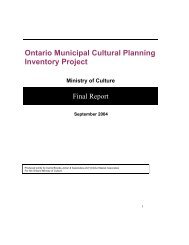
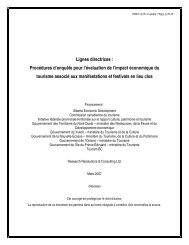
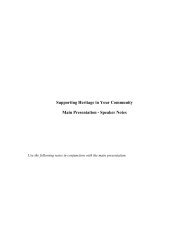
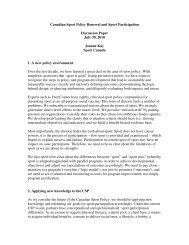
![THIS AGREEMENT made this [date], between [name of owner] (the ...](https://img.yumpu.com/49827605/1/158x260/this-agreement-made-this-date-between-name-of-owner-the-.jpg?quality=85)

